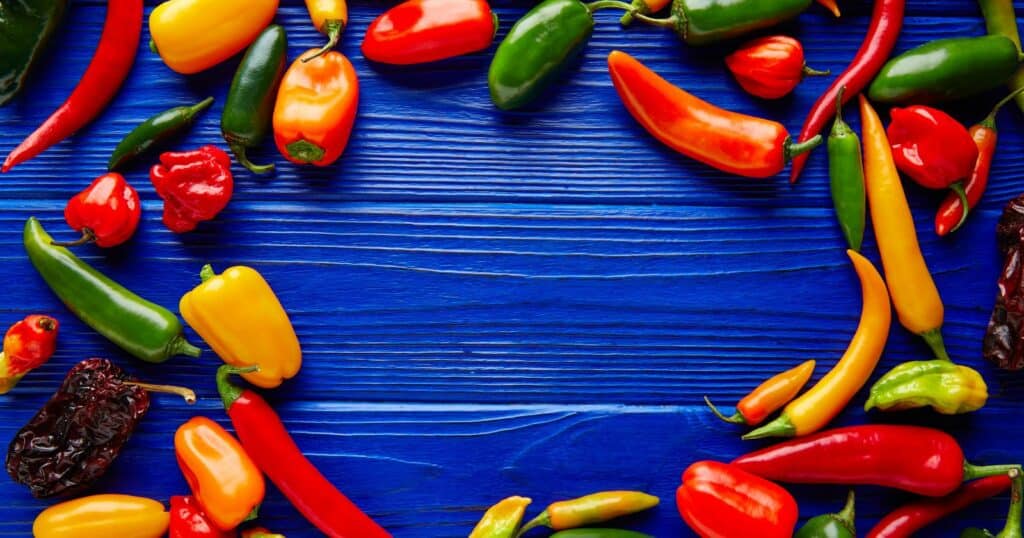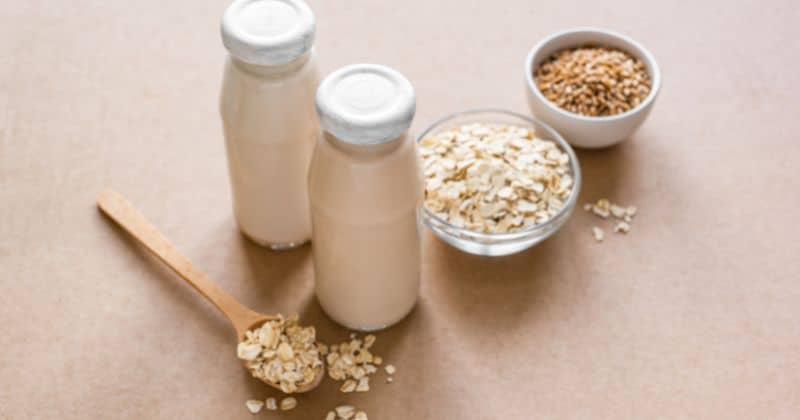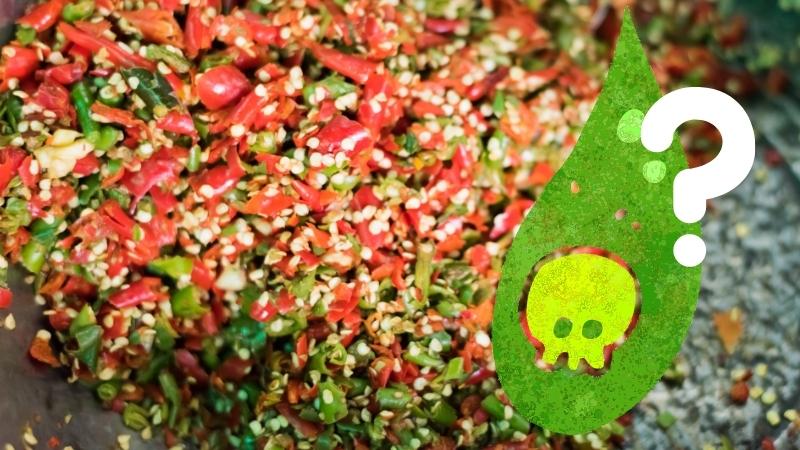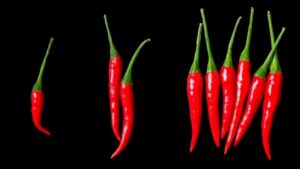If you’re a
As it turns out, the answer is more complex than you might think. While spicy foods are not automatically acidic, many popular spicy dishes contain acidic ingredients that give them a low pH.
To understand this confusing relationship between
The spiciness of peppers, curries, hot sauce and more comes not from acid, but from compounds called capsaicinoids – with capsaicin being the most notorious. On the other hand, acidity is measured using the pH scale, with lower pH meaning higher acid.
Now that we’ve unlocked the keys behind spicy and acidic foods, let’s explore how they interact in your favorite fiery dishes…
The Short Answer
Spicy foods are not automatically acidic foods. The spiciness of a food comes from compounds called capsaicinoids, not acidity. However, many spicy foods also contain acidic ingredients like citrus, vinegar, or tomato that lower the pH.
So while spiciness and acidity are independent factors, spicy foods often end up being acidic too. But not always! Let’s unpack the science behind
What Makes Food Spicy?

The spiciness of food comes from compounds called capsaicinoids, mainly capsaicin. Capsaicin is produced by various plants in the genus Capsicum, which includes peppers like jalapeños, habaneros, and ghost peppers.
Capsaicin binds to pain receptors on your nerve endings, which your brain interprets as “hot” and “spicy.” The more capsaicin a pepper contains, the hotter it tastes.
Capsaicin itself is not acidic. It is measured on the Scoville scale, which gauges the pungency and spiciness of chili peppers and hot sauces. The scale ranges from 0 Scoville Heat Units (SHU) for a bell pepper to over 2 million SHU for the Carolina Reaper, the world’s current hottest pepper.
What Makes Food Acidic?
Acidity and basicity (alkalinity) are measured using the pH scale. The lower the pH, the more acidic something is. Acidity comes from a high concentration of hydrogen ions (H+).
- Neutral pH is around 7. Pure water has a pH of 7.
- Acidic substances have a pH below 7. Lemon juice has a pH of about 2, vinegar is around 2-3.
- Alkaline substances have a pH above 7. Baking soda is slightly alkaline with a pH of 8.5-9.5.
pH decreases at higher acidity because more hydrogen ions are present. Our stomach acid has a very low pH of 1-2 to break down food.
Do Spicy Foods Have Acidic pH?
Capsaicin itself is not acidic. But that doesn’t mean spicy foods can’t be acidic too.
Many spicy dishes also contain acidic ingredients like:
- Citrus fruits: Lemon, lime, orange
- Vinegars: Rice wine, balsamic, apple cider
- Tomatoes/tomato sauce: Usually around pH 4
- Wine
Hot sauces are a prime example. They blend spicy chili peppers with an acidic ingredient like vinegar or lime to make the sauce shelf-stable. The peppers bring the heat, while the vinegar brings the tang.
Here are the typical pH ranges for common spicy foods:
- Jalapeño peppers: 5-6 pH
- Habanero peppers: 5-6 pH
- Hot sauce: 3-5 pH
- Chili with tomatoes: 4-6 pH
- Spicy Thai curry: 4-6 pH
So while spicy foods aren’t automatically acidic, many popular spicy dishes have an acidic pH due to ingredients like tomatoes, citrus, and vinegar.
Why Do Spicy Foods Cause Heartburn?

If spicy foods aren’t necessarily acidic, why do they still cause stomach issues for some people? There are a few reasons capsaicin can trigger heartburn and reflux:
- Irritation. Capsaicin irritates the esophagus and stomach lining for some people, making you more prone to pain and heartburn.
- Slowed digestion. Spicy foods may slow digestion, causing food to sit in the stomach longer and increase acidity.
- Increased stomach acid. Eating spicy foods may stimulate your stomach to produce more acid.
- Eating too much. Consuming very large, heavy meals with lots of chilies can overload the stomach.
So while spicy food isn’t acidic per se, it can still loosen the valves in the esophagus and allow stomach acid to reflux upwards. If you have acid reflux, it’s smart to limit or avoid spicy foods, even if they aren’t very acidic.
Taming the Spice : Relief for Capsaicin Burn

What should you do if you accidentally bite into an incendiary hot pepper or hot sauce overwhelms your senses? Dairy products like milk, yogurt and ice cream are your best bet for dousing the flames.
Here’s why:
- Casein, a protein in dairy, binds to capsaicin molecules and washes them away.
- Cold temperature also helps numb pain receptors.
- The fat in dairy coats your mouth and throat.
Sugary soda may seem soothing at first but can actually make the burn worse long-term. Stick to milk and yogurt if you need to put out a capsaicin fire!
In Conclusion
While spicy and acidic foods both have a reputation for causing stomach woes, spiciness and acidity don’t necessarily go hand in hand. The spiciness of peppers and hot sauce comes from compounds called capsaicinoids, mainly capsaicin. Capsaicin triggers our pain receptors but is not itself acidic.
However, many popular spicy foods like hot sauce, curries, and chili use acidic ingredients like tomatoes, limes, and vinegar, lowering the overall pH. So in practice, a lot of spicy dishes are acidic as well.
If you need relief from a mouth on fire, reach for cold, creamy dairy products. Casein binds to capsaicin to wash away the heat.
The science of spicy food reminds us that just because two food qualities are linked in our minds, like spicy and acidic, that doesn’t mean they’re linked chemically. Understanding the distinct mechanisms behind different food characteristics unlocks new recipe ideas and ways to prevent stomach troubles.
So enjoy those hot wings or extra spicy tacos, and have an antacid or cooling yogurt at the ready! With a little knowledge,
Sources
- NPR: What Made Chili Peppers So Spicy?
- Scoville Scale: The Scoville Scale for Chili Peppers
- WebMD: What Is Capsaicin?
- Scientific American: What makes things acid: The pH scale
- US Geological Survey: pH Scale
- Austin Gastroenterology: Foods That Cause Heartburn
- Science News for Students: The Cool Science of Hot Peppers
- Food Network: Mouth-on-Fire Myths: What Really Cools Your Palate
- Pick Your Own: pH of Beef, Chicken, Fish, and Pork





